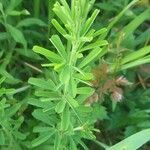Stems erect, somewhat woody, to 1.5 dm, with numerous long virgate branches, very leafy; petioles 2–5 mm; lfls ascending or erect, linear-cuneate, 10–25 mm, truncate and mucronate at the tip, glabrous above, sericeous beneath; branches sulcate, hairy on the angles; fls mostly solitary (2–3) in the upper axils, white marked with purple or pink, 7–9 mm, the wings and keel about equal; cal sericeous, the lobes lance-subulate, 3 mm, the 2 upper connate about half their length; fr oval, 3 mm; 2n=20. Native of e. Asia, cult. in se. U.S. and now planted and established along roadsides and in disturbed sites in the s. part of our range, n. to N.J., L.I., and even Mich.
Perennial, dwarf shrub, 0.8-1.0 m high; with virgate, densely leafy branches arising from a woody rhizome. Leaves with terminal leaflet not or very shortly stalked, 7-20 mm long, long-tapered to base, truncate or notched at apex; upper surface hairless; lower surface sparsely to densely hairy. Inflorescence a dense raceme, shorter than subtending leaves. Flowers often cleistogamous. Calyx ± 4 mm long; teeth acuminate. Petals whitish; standard 6-7 mm long; keel longer than standard. Flowering time Feb.-Apr. Pod 1.5-2.0 mm long, not stalked, hairy.
A small shrub up to 1 m tall. The leaves have 3 leaflets. These are narrow. They are 10-25 mm long by 2-4 mm wide. There are hairs on the lower side of the leaf. There are 2-4 flowers in the axils of the leaves. The flowers are whitish-yellow with violet stripes near the base. The fruit are oval pods 3 mm long.




